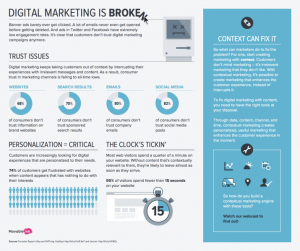This guest post was submitted by Felicia Spahr.

Back when I was a marketing consultant, I was quick to become a student of any persuasion books I could get my hands on. Like most salespeople, reading Robert Cialdini’s Influence changed how I thought about the art of getting people to do what you want them to do.
So when I discovered how to use ‘scarcity’ in selling, it seemed like a magic pill you could put onto any sales pitch or marketing campaign and Voila! You have a buyer.
What the principle doesn’t take into consideration is that not all people are ‘easy sells’, despite how strong your scarcity may be. And worse, most people can tell when a sales pitch starts to remind them of late nights watching power juicer infomercials. Something is nagging at them, telling them that the scarcity–despite it’s persuasive pull–might not be ‘real’.
And the worst thing any salesperson can do is come off as inauthentic.
So if you can’t ethically use scarcity (if you have a digital product or SaaS service, for example, where the product is in unlimited supply) what can you do to close your next deal faster?
I’m going to share with you 3 questions to ask your prospect that will make them feel the urgency to buy without you needing to say “Only 1 spot left!”.
3 Questions To Create Urgency To Buy in Your Prospect:
Question #1: How would this help your business if you had this now?
So often, we find ourselves talking at the prospect with a slew of benefits after benefits without hearing from them what THEY think the product or service will do for them.
So when you ask them “How would this help your business if you had this now?” they start to imagine how the business would be different and better because of what you’re offering them. You’ll hear them describe it in their own words, which gives you clues into what’s actually a priority for them vs. you thinking that every aspect of your sales pitch is important.
What this does for you: You hear the client describe in their own language what matters to them right now (and what they could care less about) which you can use in your conversation as a way to move them closer to ‘Yes’. As a bonus, this question takes advantage of Cialdini’s studies on ‘abundance, then scarcity’, where people are given a ‘free trial’ of what they want and then have it not be available anymore. The only way for them to get it back is to buy.
By having your potential client imagine what would be different and then realize that’s not what they have now, they start to feel like they’re missing out on the incredible results they could be getting now vs. a vague time in the future.
Question #2: What would happen if you didn’t invest today?
As we’re doing the dance of convincing and persuading, we forget to talk about the costs of not buying your product or service. In fact, most prospects are building up their own cases for reasons not to buy as we continue to throw facts and figures at their wallets.
So instead of thinking of yourself as a ‘salesperson’, think of yourself as an advisor. If you were an advisor, your role would be to help your qualified lead make the best decision possible for them. In that case, you would openly discuss ALL sides of the deal — not just the positive aspects so you can be quick to close.
What this does for you: Asking this question not only develops deep trust and rapport (“Wow, he’s not trying to sell me right now?”, the prospect thinks), but gets your potential client to seriously consider the costs of not making an investment. What will they lose? What will they miss out on? How will it impact their biggest priorities (which Question #1 helps you uncover)? People are loathe to admit what they would be losing out on, especially if loss of revenue and wasted time are at stake.
Question #3: What other options are available for you?
In any service I’ve sold in the past, one of the objections that came up over and over again was: “Can’t we do ‘X’ ourselves?”
Most people want to believe that all they have to do is read more books, solve a problem with an internal team, or simply ‘just figure it out’.
What I realized was that they weren’t coming up with these objections because they couldn’t use what I had to offer. They wanted to be sure that if they did make an investment that they’d be making the right decision, and that they wouldn’t be wasting their time. This is the beauty of the scarcity principle: no one wakes up in the morning and thinks “I’d like to waste time today!”
What this does for you: So as an advisor (not a salesperson) it’s in your best interest to listen to what your potential client feels all of their other options are in solving their problem. You want to find out what they’ve been doing, if they’ve been successful (or unsuccessful, and why not) and how wasting time with options that don’t help them significantly affects what’s most important to them. Especially if what you sell is directly tied to revenue in any way, you’d be hard pressed to find someone who is actively interested in wasting not only time, but money.
Why This Kind Of ‘Scarcity’ Works
All the questions I’ve presented to you today are a simple reframe of the scarcity principle. They’re designed to get your prospect creating their OWN sense of urgency, instead of us trying to force it down their throats. In some cases, you have clients who just aren’t the best fit and can’t afford or use your service for a variety of reasons.
But when you have a qualified lead that you know could benefit exponentially from what you have to sell, then it’s your obligation to ethically use scarcity so it takes you from a salesman with a sales pitch, to a trusted advisor having a conversation with a smart buyer. And a smart buyer who knows you have his best interests at heart.
What to Do Today
The next time you pick up the phone or are out selling, try these 3 questions and measure what kind of results you get from them. Measures of success would be your prospect opening up about what their true priorities actually are, having a discussion with you about all the options, and of course–closing your next deal much faster.
(194)







